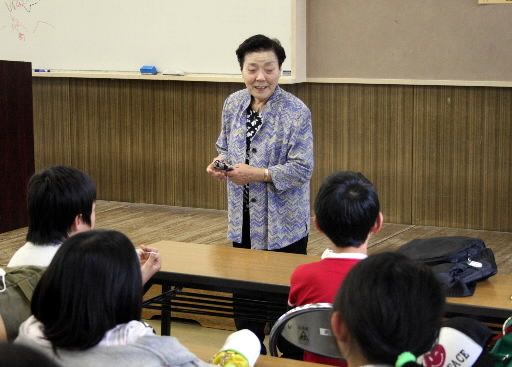Sharing the A-bomb Experience, Part 2
Aug. 1, 2009
Bearing witness to a brother's life
by Uzaemonnaotsuka Tokai, Staff Writer
In late May, some 80 elementary school students from Kochi Prefecture were in a conference room at Hiroshima Youth Center. They were visiting Hiroshima on a school trip and listening to Yoshiko Obatake, 83, a Hiroshima resident. It was the first time Ms. Obatake, an A-bomb survivor, spoke to such a large group of people about her experience of the atomic bombing 64 years ago.
She had written what she wanted to say on eight sheets of paper and was well prepared. Until she retired 20 years ago, she had been a schoolteacher so she felt no nervousness about speaking to the children.
But about 10 minutes into her talk, when she began to describe finding her brother’s lifeless body, her speech became halting. “I realized it was my brother,” she said, her shoulders trembling. She covered her mouth with a handkerchief, then continued. “I called his name, ‘Kozo,’ but he didn’t respond. I rubbed his back and it was still warm.”
On the day of the bombing, Ms. Obatake left home in the city center and went to Ujina Elementary School, where she worked. The school was not far from Hiroshima Bay. Before the morning assembly, she was in the teachers’ room. As her eyes happened to fall on the clock, she heard a tremendous explosion and saw the huge mushroom cloud from a window.
Hurrying home, she saw bodies sprawled over one another on a riverbank. Among them was a mother with a baby in her arms. Two days later, she was reunited with her mother and sister at her relatives’ house in Hachihonmatsu-cho (now, Higashi Hiroshima), but her brother did not turn up there. At the time of the blast, he was in Zakoba-cho (now, Kokutaiji-machi) helping to dismantle houses to create a fire lane. He was 15 and a second-year student at the former Shudo Junior High School.
Ms. Obatake returned to Hiroshima and searched for him at relief stations in the city. After three days, she received a clue to his whereabouts, but another three days passed before she came to a relief station at an elementary school in Kannon-mura, (now, Saeki Ward) with her mother and sister. On August 12 they found a naked boy, lying on his stomach outside the auditorium. The boy remained still as they approached.
It was her brother.
As his back was warm, he may have passed away just moments before. “I’m so sorry,” Ms. Obatake said to him. “You were waiting for us. I’m so sorry.”
“I felt that I could have saved him if I had arrived a day earlier, even an hour earlier,” she recalled. She became tormented by remorse over not reaching her brother before his last breath. As time passed, the remorse grew deeper and the experience so painful to consider that she would no longer talk about him.
But when she thought of how little time was left in her own life, she started to feel differently. “I wanted to tell people about my brother, who died such an unfortunate death. Perhaps I can bear witness to my brother’s life by conveying the horror of the atomic bombing.” Her husband Hajime, 85, found an opportunity for her to share her experience with students on a school trip.
After her first talk, some students came up to her and stood in a line to shake her hand. Gripping each child’s hand, she told them emphatically, “Don’t grow up to fight in a war.”
The students seemed to be about the same height as her brother, who was small in stature. Feeling the warmth of the children’s hands, she discovered the significance of sharing her story.
(Originally published on July 24, 2009)








